Dodecylamine-mediated synthesis of caron-supported platinum-ruthenium alloy nanoparticles with ultrafine sizes towards high-efficiency methanol oxidation electrocatalysis
IF 7.1
2区 材料科学
Q2 MATERIALS SCIENCE, MULTIDISCIPLINARY
Progress in Natural Science: Materials International
Pub Date : 2025-02-01
DOI:10.1016/j.pnsc.2024.12.011
引用次数: 0
Abstract
For fully leveraging the advantages of PtRu alloys as electrocatalysts to catalyze methanol oxidation reaction (MOR), we herein report an ambient-temperature method for directly synthesizing carbon-supported PtRu alloy nanoparticles with ultrafine sizes in an organic medium towards high-efficiency MOR. This strategy involves the dodecylamine (DDA)-mediated extraction of Pt and Ru ions from water to toluene, and then mixing them with carbon substrate, followed by NaBH4 reduction in the same organic medium. Profiting from their ultrafine sizes of ca. 1.68 nm, the as-prepared PtRu nanoparticles supported on carbon substrate show a mass activity of 0.93 A mg−1 and a specific activity of 10.56 mA cm−2, respectively, both of which are much higher than those of the commercial PtRu/C catalyst.

十二胺介导的碳负载超细铂钌合金纳米颗粒的合成及其高效甲醇氧化电催化研究
为了充分利用PtRu合金作为电催化剂催化甲醇氧化反应(MOR)的优势,本文报道了一种在有机介质中直接合成碳负载的超细PtRu合金纳米颗粒以实现高效MOR的环境温度方法。该策略包括十二烷基胺(DDA)介导的Pt和Ru离子从水中提取到甲苯,然后将它们与碳底物混合,然后在相同的有机介质中进行NaBH4还原。由于其超细尺寸约为1.68 nm,所制备的PtRu/C纳米颗粒负载在碳衬底上,其质量活性为0.93 a mg−1,比活性为10.56 mA cm−2,两者均远高于商用PtRu/C催化剂。
本文章由计算机程序翻译,如有差异,请以英文原文为准。
求助全文
约1分钟内获得全文
求助全文
来源期刊
CiteScore
8.60
自引率
2.10%
发文量
2812
审稿时长
49 days
期刊介绍:
Progress in Natural Science: Materials International provides scientists and engineers throughout the world with a central vehicle for the exchange and dissemination of basic theoretical studies and applied research of advanced materials. The emphasis is placed on original research, both analytical and experimental, which is of permanent interest to engineers and scientists, covering all aspects of new materials and technologies, such as, energy and environmental materials; advanced structural materials; advanced transportation materials, functional and electronic materials; nano-scale and amorphous materials; health and biological materials; materials modeling and simulation; materials characterization; and so on. The latest research achievements and innovative papers in basic theoretical studies and applied research of material science will be carefully selected and promptly reported. Thus, the aim of this Journal is to serve the global materials science and technology community with the latest research findings.
As a service to readers, an international bibliography of recent publications in advanced materials is published bimonthly.

 求助内容:
求助内容: 应助结果提醒方式:
应助结果提醒方式:


